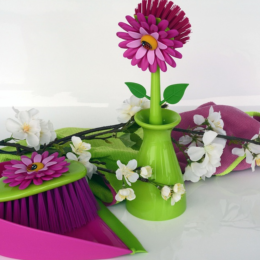By Amy Kossoff Smith
Spring Cleaning, an annual cliché, can go way beyond dust bunnies and baseboards. Parenting expert offers ways to get your family, house, and kids all tuned up
It’s amazing that we’re (usually) diligent about changing our oil to make sure our car runs smoothly; visiting the doctor for annual check-ups; and attending to other preventive maintenance activities on assorted things. But the most important part of our life – family, house, kids – can unravel quickly in piles of “to do’s,” “should’ve dones,” and more – if we don’t have good systems in place for staying organized and systematic in how we approach daily tasks. Internationally recognized parenting expert, Amy Kossoff Smith, revels in “tips and tools for the business of motherhood” through her website, The MomTini Lounge. “We can take the ‘spring cleaning’ cliché a step further this year, by applying that same enthusiasm and fervor to our family, house, kids this year,” she says, adding of course, that she doesn’t mean spraying Windex on junior!
“We all know that an oil change helps our car run more smoothly. Imagine the benefit of investing in a family/house/kids tune-up by applying some simple principles to organizing our life,” she says.
The key benefit, according to Smith, is that Mom’s (& Dad’s) “energy deficit” at the end of each day can dramatically decrease and make them feel more confident, satisfied, and “uncluttered.”
Teamwork is Key
Too often, it’s easier to do the job ourselves than to engage the help of others. We promote teamwork through sports, put our kids in uniforms to celebrate the “membership” with their peers, but too often, Smith says, we forget to implement teamwork at home. “Consider a “team” meeting where the family sets aside a certain time each week to put together a game plan. After dinner, put on some fun music, and tell everyone it’s a clean-up party until the job is done,” she suggests.
Make Chores Work
One of Smith’s favorites, “What a Chore to Make Chores Work” says just that. It does take some work to set up a chore system, but the paybacks are endless. She advocates giving chores creative titles to increase compliance and enthusiasm with the kids. For example, the “electrician” turns off the lights; the “Assistant Chef” helps at mealtime. It takes a little bit of effort to set up a chores system, but imagine the relief when half of your “to do list” is being done by others! Plus, Smith says, “You’re helping your children not only develop a work ethic early on, but you’re showing them a healthy dynamic in a family where everyone makes a valuable and necessary contribution.”
Post Responsibilities, and Vary the Tasks
Smith recommends posting a chore chart, especially when kids are young, so they see what is expected of them. “Think about age-appropriate jobs for everyone in the house, and consider varying the tasks every so often to prevent ‘chore fatigue,’” she suggests. “Kids can help at any age; little ones can sort laundry; big kids can DO laundry,” she says. “Guaranteed, our kids’ electronic games and consoles are more complicated than a washer/dryer, but we’re hesitant to get them to help, or we’re tired of asking over and over again. Just do it! You’ll be glad you did, and your kids will feel satisfaction after a job well done.”
You can use a write on/wipe off chart where kids can check off completed jobs, or any system that works for your family.
Chart it!
Smith is a huge fan of “charting” tasks, to-do’s, and important information. Her favorite is the importance of “Tracking Medical History” where you keep track of each family member’s major illnesses (sniffles, step aside, but track whenever you go on antibiotics or have major medical events). “This gives you a reference point, and also helps your doctor prescribe the most effective path to wellness, especially if you keep notes about what works, what doesn’t, what gives you problems when you take it,” she says. “This same philosophy can apply to carpools, birthday party RSVP’s and gifts, and more,” she says.
This can apply to any task you have; if you organize it in categories, you’ll be able to accomplish (and track) it much more easily.
De-Clutter Closets
The change of seasons is a perfect time to prescribe the “out with the old, in with the new” spirit. “Plastic bins can be your best friend; they let you store things neatly, and you can see through for quick access later on,” Smith says. Buy a variety of sizes & styles, and store out of season items by category (hats, gloves in one; winter sports uniforms in another; and so on). Plastic bins can also stack to store in-season items you’ll need to find quickly. Think about some categories you’ll need frequent access to, and store them in a container that will close and stack, so you can find it when you need it (sunscreen, swim goggles, flip flops, for example).
“Also, kids grow year to year, so think about going through each kids closet and storing for your next child or, when you’re done with that size, donate it!” Smith says. “I keep an empty box in each kid’s closet with a post-it note that says ‘too small’ so they can dump as they go rather than putting that tight pair of jeans back into circulation in their own closet week after week,” she shares.
De-Clutter Garages and Common Areas
De-cluttering is really the “heart and soul” of a spring clean-up, Smith says, so it deserves some more detail. “The garage becomes a dumping ground for so many things, that we joke about the ‘dance’ it takes to wedge yourself between the car and the wall just to get inside,” says Smith. “Let your kids play on the driveway if they’re old enough while you attack the beast more affectionately known as the garage.” Think about other areas (foyer closet, powder room cabinets) that could use a purge, and trash or donate unused items to make space.
So, even if your spring clean-up turns into a summer activity, you now have a game plan and some easy tactics to get the job rolling.
Amy Kossoff Smith is Founder of The MomTini Lounge (www.MomTiniLounge.com), a site dedicated to teaching parents “tips and tools on the business of motherhood.” Smith is a nationally recognized source on parenting and has appeared on The Today Show, FOX, NBC, CBS, and ABC News. A national wire columnist , Amy reports on parenting topics and is published in newspapers nationwide and has a successful public speaking platform. She authored an essay called “Stumbling into Cyberspace” in Knowing Pains: Women on Love, Sex and Work in our ‘40s.

















